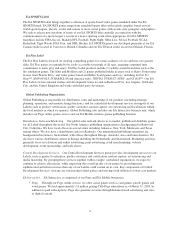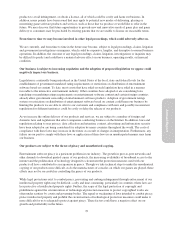Electronic Arts 2009 Annual Report Download - page 96
Download and view the complete annual report
Please find page 96 of the 2009 Electronic Arts annual report below. You can navigate through the pages in the report by either clicking on the pages listed below, or by using the keyword search tool below to find specific information within the annual report.the PlayStation 2, may be greater or faster than we anticipate, and sales of products for the new platforms may be
lower or increase more slowly than we anticipate. Moreover, development costs for the current cycle of video
game systems continue to be greater on a per-title basis than development costs for prior-generation video game
systems. In addition, in light of the current economic environment and where we stand in the current generation
console cycle, our industry may experience slower growth than in recent years. As a result of these factors,
during the next several quarters and years, we expect our operating results to be difficult to predict.
Technology changes rapidly in our business and if we fail to anticipate or successfully implement new
technologies in our games, the quality, timeliness and competitiveness of our products and services will
suffer.
Rapid technology changes in our industry require us to anticipate, sometimes years in advance, which
technologies we must implement and take advantage of in order to make our products and services competitive in
the market. Therefore, we usually start our product development with a range of technical development goals that
we hope to be able to achieve. We may not be able to achieve these goals, or our competition may be able to
achieve them more quickly and effectively than we can. In either case, our products and services may be
technologically inferior to our competitors’, less appealing to consumers, or both. If we cannot achieve our
technology goals within the original development schedule of our products and services, then we may delay their
release until these technology goals can be achieved, which may delay or reduce revenue and increase our
development expenses. Alternatively, we may increase the resources employed in research and development in
an attempt to accelerate our development of new technologies, either to preserve our product or service launch
schedule or to keep up with our competition, which would increase our development expenses.
The video game hardware manufacturers are among our chief competitors and frequently control the
manufacturing of and/or access to our video game products. If they do not approve our products, we will
be unable to ship to our customers.
Our agreements with hardware licensors (such as Sony for the PLAYSTATION 3, Microsoft for the Xbox 360,
and Nintendo for the Wii) typically give significant control to the licensor over the approval and manufacturing
of our products, which could, in certain circumstances, leave us unable to get our products approved,
manufactured and shipped to customers. These hardware licensors are also among our chief competitors.
Generally, control of the approval and manufacturing process by the hardware licensors increases both our
manufacturing lead times and costs as compared to those we can achieve independently. While we believe that
our relationships with our hardware licensors are currently good, the potential for these licensors to delay or
refuse to approve or manufacture our products exists. Such occurrences would harm our business and our
financial performance.
We also require compatibility code and the consent of Microsoft, Sony and Nintendo in order to include online
capabilities in our products for their respective platforms. As online capabilities for video game systems become
more significant, Microsoft, Sony and Nintendo could restrict the manner in which we provide online capabilities
for our products. If Microsoft, Sony or Nintendo refused to approve our products with online capabilities or
significantly impacted the financial terms on which these services are offered to our customers, our business
could be harmed.
The video game hardware manufacturers set the royalty rates and other fees that we must pay to publish
games for their platforms, and therefore have significant influence on our costs. If one or more of these
manufacturers change their fee structure, our profitability will be materially impacted.
In order to publish products for a video game system such as the Xbox 360, PLAYSTATION 3 or Wii, we must
take a license from Microsoft, Sony and Nintendo, respectively, which gives these companies the opportunity to
set the fee structure that we must pay in order to publish games for that platform. Similarly, these companies
have retained the flexibility to change their fee structures, or adopt different fee structures for online gameplay
and other new features for their consoles. The control that hardware manufacturers have over the fee structures
for their platforms and online access could adversely impact our costs, profitability and margins. Because
publishing products for video game systems is the largest portion of our business, any increase in fee structures
would significantly harm our ability to generate profits.
16
























